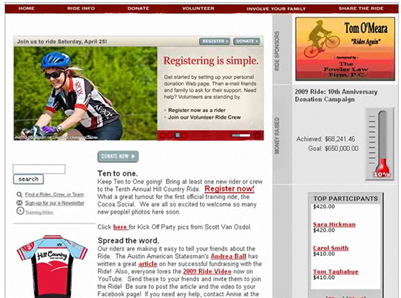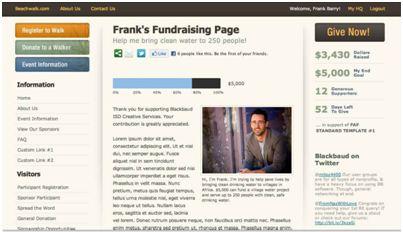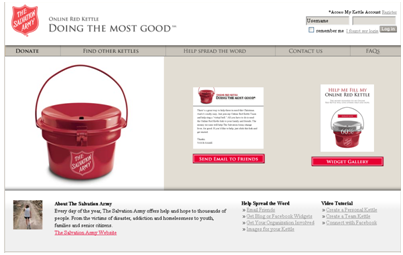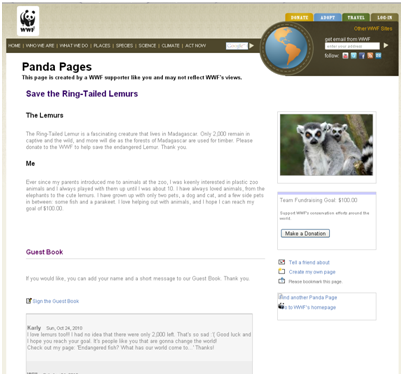Peer to Peer Fundraising in the Digital Age
Back in the day, peer-to-peer fundraising was done with phone calls, letter-writing campaigns, and in-person visits. Now we have a whole new universe of not only digital communication, but digital relationships. Recently, I came across a cool infographic from Blackbaud that illustrated the power of harnessing online social networks to raise money for charity. It got me thinking- what are organizations doing to take advantage of this?
Peer to Peer Products
Peer to peer fundraising tools offered by Blackbaud (Friends Asking Friends) and Convio (Team Raiser) enable team members and participants to set personal fundraising goals and then go about asking friends and family for donations, the deadline for raising funds usually being an organizational event (primarily races to cure diseases). In fact, according to the Chronicle of Philanthropy, all of the top five P2P Giving organizations in 2010 were health organizations (for the top 25 online giving orgs of 2010 view slide 8 here).
-

-
Convio's Team Raiser

-

-
BlackBaud's Friends Asking Friends- thanks
Frank Barry!

If you put on these participant-heavy events, here’s a post about 3 ways to add new event participants. But according to a webinar by Blackbaud on Tuesday, you don’t have to have an event in order to use these tools. Organizations are using them both with ongoing fundraising and with virtual or digital events as well.
Website Tools
Both the Salvation Army and the World Wildlife Federation have cool things that are like the peer to peer tools above, but are designed for ongoing fundraising. The Salvation Army has an “Online Red Kettle”. You can either start your own red kettle, donate to an existing one, or send an eCard to your friends (via email) urging them to support one. If you set up your own, you can have your own fundraising meter, banner ad, or Facebook app.
-

-
Online Red Kettle

On the WWF’s site, you can search for or make a super-cute Panda Page (it can be for any animal), then email it to your friends and family. As of right now there weren’t any social media plug-ins on the page.
-

-
World Wildlife Federation Panda Page

Another way to configure your website to encourage peer-to-peer fundraising (also suggested by Frank Barry and Steve MacLaughlin of Blackbaud) is to immediately prompt online donors to share with their social networks when they make a gift, instead of only receiving a regular confirmation page or email. Use Facebook and Twitter plug-ins (like and share buttons, retweets etc) to make it simple for them to share with their networks.
You can also embed those same plug-ins in different areas of your website. Enable somebody to “like” a concert, or retweet a story about your outreach program.
Facebook Causes
Causes has alternately been held up as a model for success and derided for not delivering on its promises. The basic idea is that it allows anyone to create an advocacy group, or “cause”. This cause can then raise funds to donate to a charity. One of the most successful causes is The Nature Conservancy, which has raised over $400,000. An arts success story is Keep the Arts in Public Schools, created by Americans for the Arts, which has raised almost $50,000. People can become members of the cause, donate, tell friends, and “give a minute” by watching and participating in ads that earn money for the cause.
Aaron Hurst of Taproot has been a critic of Facebook Causes since his organization devoted $3,000 of staff time to creating their Cause shortly after Facebook launched the feature. They have received only $60 in return to date. Is Causes a rip-off or a revolution in fundraising? The jury’s still out, but it’s my guess that the different results are due to a combination of knowing how to facilitate peer-to-peer fundraising well, an organization’s existing fan base, and the type of cause. It’s interesting to note that at the Nature Conservancy, social networking was never primarily about raising money- it was “first and foremost a tool for brand and reputation,” said an organizational representative in this 2009 Washington Post article.
Kickstarter
Much has been written about Kickstarter and its cousins, IndieGoGo and RocketHub (among others- check out Pat’s article from last year). And certainly anyone using these tools knows that it’s all about mobilizing your social network. It’s really better suited to specific projects than ongoing fundraising, however. And unless you are able to get your supporters to in turn appeal to their own friends, you are probably going to be asking the same people you always ask anyway.
According to a recent article from NPR, Kickstarter has raised over $50M for creative projects since launching in 2009 and currently attracts $2M in pledges each week for projects.
Check out this Mashable article on other social fundraising alternatives.
The philosophical side
There’s a lot more to this than just raising more money. It’s also about building donors of the future, and increasing not just donations but engagement that will later lead to donations.
On Wednesday, the Case Foundation hosted the Millennial Donors Summit to talk about millennials’ approach to charitable giving. A lot of the points that were made apply not only to millennials, but also to peer-to-peer and social media fundraising. The following is excerpted from Katya’s Non-Profit Marketing Blog:
- It’s not about telling millennials to support you; it’s about creating a vested interest in what you are doing with joint ownership. Let millennials manage your community, design your logo or otherwise be an active partner in what you seek to accomplish.
- At some point, you have to build an army. You can only sell something yourself so many times—you need your community doing it for you, performing the heavy lifting. So give them ownership.
- To be trusted on the web, be an individual, not an organization.
- Look for the small yes.
Something that Frank and Steve mentioned in their webinar this week is that it’s more important to tell a compelling story than it is to make the ask when using social media to fundraise. They gave examples of YouTube videos where the ask was a subtitle. The story is what gets people interested.
Also, give them something to do besides donate. Encourage them to like your page, share the link or video, comment, or even answer a question (like at Free Rice) or send mom a card.
Many of these examples are from very large organizations that have teams of people to create these web tools. But these ideas can be applied on a smaller scale. How have you empowered your constituents to raise money and awareness for you? Do you know of arts organizations who are doing it successfully?